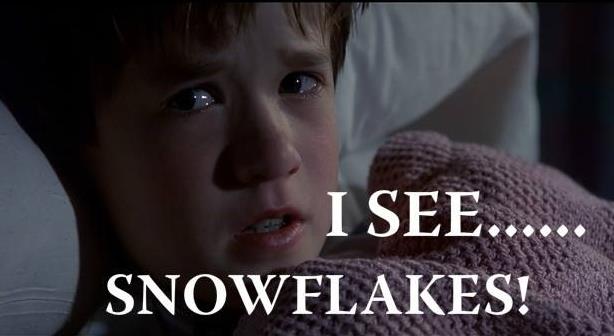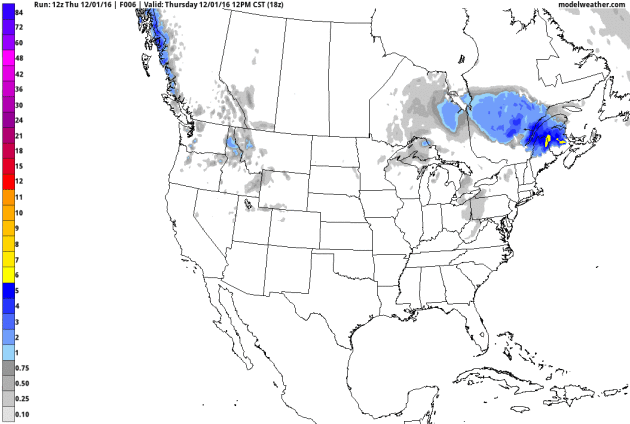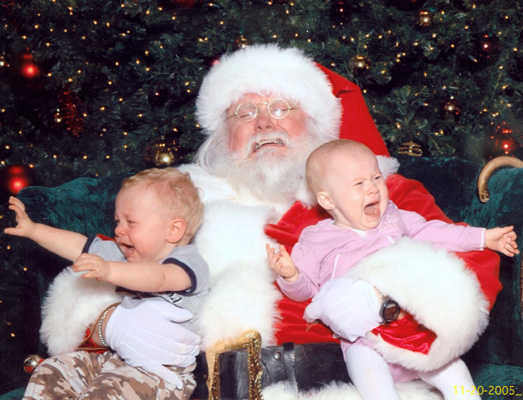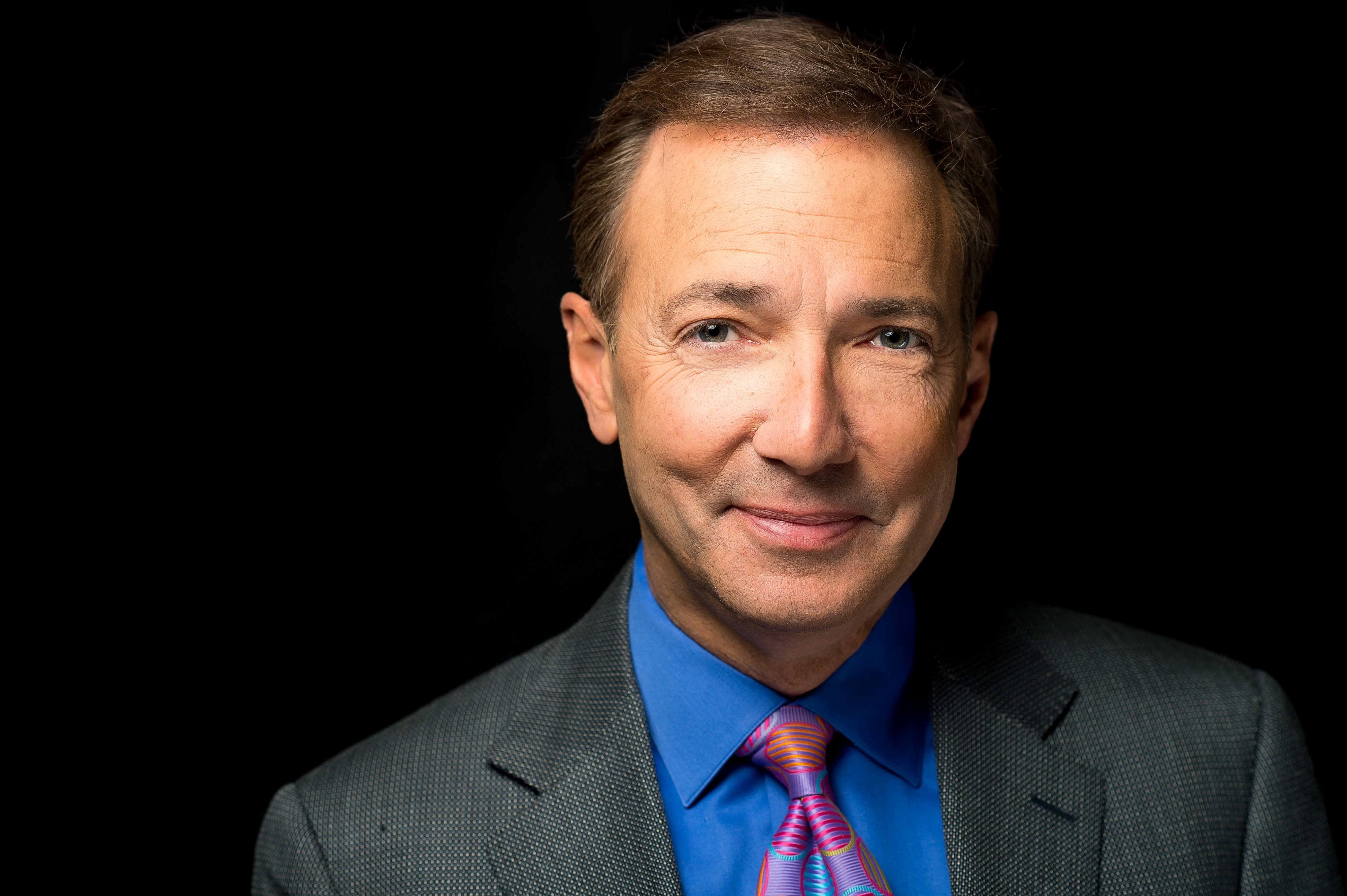32 F. average high on December 1.
34 F. high on December 1, 2015.
December 2, 1985: Record low highs are set in north and east central Minnesota with temperatures ranging from the single digits below zero to the singles digits above. Alexandria was the cold spot with a high of 4 degrees Fahrenheit below zero. Other record low high temperatures included Redwood Falls with 3 below, Long Prairie with zero, and Litchfield and Little Falls with 5 degrees above zero.
December 2, 1982: A record high of 63 degrees is set at the Twin Cities.

After a Warm 2016 December Will Bring Payback
"Winter is nature’s way of saying, "Up yours." wrote Robert Byrne. Then again, the atmosphere doesn't play favorites. It reacts to forcings: a low sun angle, long nights, interactions with oceans, arctic ice & CO2. Seemingly chaotic and infinitely complex, weather results from uneven heating and cooling; an atmosphere in search of equilibrium which never quite comes.
But there CAN be payback!
Long stretches of abnormally warm weather are often followed by jabs of brutally cold air. We just enjoyed 2 Octobers in a row; November was 10.4F warmer than average in the Twin Cities. Minnesota is due for a "correction". And it's coming.
Like ocean swells breaking in a rising tide bitter air won't arrive all at once. By the end of next week, teens and 20s. By mid-December we may dip below 0F.
Too much cold air arriving too fast can push the storm track south/east of MSP. Latest model runs suggest heavy snow falling on Iowa & Wisconsin Wednesday/Thursday of next week. A very close call.
It was a nice long vacation from wind chill. Almost time to dig out the parkas and welcome winter!

84-Hour Forecast.
The animation above shows hour by hour predicted precipitation and
isobars into Sunday evening. Rain and snow showers linger for northern
New England; a cold rain blossoms by Saturday over Texas with a shield
of rain advancing into the Mid South, Midwest and Ohio Valley, mixed
with snow from the Texas Panhandle into Iowa and Minnesota Sunday.
Source: Tropicaltidbits.com.

10-Day Snowfall Potential.
Here is the GFS solution, showing plowable snows downwind of the Great
Lakes, far northern Minnesota and the higher terrain of the Pacific
Northwest by Sunday morning, December 11. Animation: AerisWeather.
A Balmy November.
All those cities with red dots experienced the warmest November on
record, in most cases dating back to the late 1800s. Map: NOAA NCDC and
Aeris AMP.
November Precipitation.
The wettest weather last month was observed from northern California
into western Oregon and Washington State. Significant rains fell fromm
Texas into the Mid South late in the month, but not enough to erase an
extended and debilitating drought.
November Precipitation Departure From Normal. The Upper Midwest and coastal Pacific Northwest was considerably wetter than average last month, but drier than average weather prevailed for much of the eastern USA.
Top 10 Driest November. Florida gets the Goldest Dust Award with 8 cities experiencing one of the 10 driest Novembers on record. The pattern is shifting; the arrival of much colder Canadian air capable of spinning up more numerous, intense (and wet) storms from coast to coast in the weeks ahead.
Serious Catching Up To Do.
A couple of storms won't pull the southeastern USA out of extreme to
exceptional drought. It will take the better part of 2-3 months of
consistently wetter than average conditions to recharge soil moisture,
lakes, rivers and reservoirs.
Extreme Tornado Outbreaks Are Happening More Often Across the U.S. Is there a climate connection or is this a meteorological coincidence? It's unclear. But wind shear (helicity) is on the increase, creating an environment more ripe for tornadoes. Gizmodo reports: "Tornadoes that come in bunches are on the rise in the United States, according to a new study. Though it might be tempting to blame climate change, scientists aren’t entirely sure what’s causing this troubling trend. From 1965 to 2015, the frequency of tornado outbreaks—that is, six or more tornadoes that occur in close succession—has increased in the continental United States, according to a new study published in the journal Science. Alarmingly, these extreme weather clusters have caused nearly 80 percent of tornado-related fatalities between 1972 and 2010. The Columbia Engineering scientists who conducted this research say tornado outbreaks are not just increasing in frequency over time, they’re also increasing in terms of severity. The scientists are at a loss to explain why this is happening, and say further research is warranted..."
Photo credit: "A pair of tornadoes seen near Pilger, Nebraska, in June 2014". (Image: Eric Anderson/AP).
Graphic credit above: "The number of tornadoes spawned in outbreaks has been increasing, according to researchers at Columbia University and Rockefeller University. Tornado strength is measured on the Fujita scale, with F5 being the most powerful." Michael K. Tippett and Joel E. Cohen, Nature Communications, February 2016.
Busiest Atlantic Hurricane Season Since 2012. Details via NOAA: "As
the Atlantic, eastern Pacific and central Pacific 2016 hurricane
seasons end today, NOAA scientists said that all three regions saw
above-normal seasons. For the Atlantic, this was the first above-normal
season since 2012. The Atlantic saw 15 named storms during 2016,
including 7 hurricanes (Alex, Earl, Gaston, Hermine, Matthew, Nicole,
and Otto), 3 of which were major hurricanes (Gaston, Matthew and
Nicole). NOAA’s updated hurricane season outlook in August called for 12
to 17 named storms, including 5 to 8 hurricanes, with 2 to 4 of those
predicted to become major hurricanes. Five named storms made landfall in
the United States during 2016, the most since 2008 when six storms
struck. Tropical Storm Bonnie and Hurricane Matthew struck South
Carolina. Tropical Storms Colin and Julia, as well as Hurricane Hermine,
made landfall in Florida. Hermine was the first hurricane to make
landfall in Florida since Wilma in 2005..."
GOES-R Is Now GOES-16! Good news from NOAA NESDIS: "November
29, 2016, NOAA's GOES-R satellite executed its final liquid apogee
engine burn without anomaly. This has placed the satellite approximately
22,000 miles away with an inclination of 0.0 degrees, meaning it has
reached geostationary orbit. GOES-R is now GOES-16! Later today, GOES-16
will perform its second stage solar array deployment, releasing the
solar array yoke and solar pointing platform. In the days that follow,
the software will be transitioned from the 'orbit raising' mission phase
to 'operational,' several maneuvers will be conducted to adjust the
satellites precise orbit, and the magnetometer boom will be deployed.
Testing and calibration of GOES-16 will then begin."
The Long, Politically Fraught History of Seeds in the U.S. Remember when the government used to give seeds away? Here's a clip from a story, courtesy of Tedium and Atlas Obscura: "When you’re looking to plant a fresh urban garden, it’s natural to hit your local store and buy a bunch of tomato seeds, perhaps some carrot seeds, and maybe you’re in the mood for some spice, so you add a couple of habanero seeds to the cart.
Soon, you might plant these seeds in the ground, without even giving a
second thought to the fact that you showed your support to the
commercial seed industry. It’s a heckuva lot larger than you’d think, bringing in $45 billion globally
each year according to the American Seed Trade Association. Now, you
might be wondering to yourself, “Wait, $45 billion? How? Can’t
commercial farmers just use the seeds left over by the plants they
grow?” Well, this issue is way more complicated than that. And, largely,
you can thank genetically modified crops, and, more specifically, the
1980 Supreme Court case that paved the way for them..."
Photo credit: "Seeds on display". liz west/CC BY 2.0
Study Finds Conservative and GOP Support for Clean Energy. Here's an excerpt from Milwaukee Journal Sentinel: "...Among the findings in the survey was widespread support for solar power and for state utility rules known as net metering that ease the path both for homeowners to add solar and dairy farmers to generate electricity from manure digesters. Other key findings:
- 70% of voters surveyed believe the U.S. should put more emphasis on wind energy production, and 76% support increased solar production. More than half of those polled think the country should put less emphasis on coal, with just 23% favoring more emphasis on coal.
- Republican, Democrat and independent voters all show strong support for adoption of an energy optimization standard in their state, under which utilities are required to help customers reduce energy consumption through energy efficiency programs and products..."
Photo credit: "Surveying equipment as part of a microgrid demonstration and competition."
Clean Energy Gains Ground - But Old Dirty Habits Die Hard. Here's the intro from Reuters: "Solar power is becoming so cheap so fast that in Abu Dhabi it's now less costly to produce a unit of energy from the sun than from oil, leading energy experts said this week. But that doesn’t mean a global switch to renewable energy will be inevitable or speedy, they told a London conference. Difficult and sometimes unexpected problems still stand in the way, including pension funds heavily invested in fossil fuels, upfront costs for clean power, political flip-flops in key nations, and the lobbying prowess of old energy companies..."

See What People of 1967 Imagined The World Would Be Like in 1999. Is this a young Bill Gates pondering Windows back in the 60s? Wait, my PC still looks like this, come to think of it. The video from Atlas Obscura is worth checking out. As Yogi Berra said: forecasts are hard, especially about the future: "...This short film, produced in 1967 by the Philco-Ford Corporation, a maker of battery-powered tech, imagines the distant future of the year 1999. Amid all the mid-century-modern set dressing, they actually got a lot of things right. In this “society of tomorrow,” we can see precursors to personal computers, email, FaceTime, podcasts (complete with the 2x speed feature), online shopping, 3D imaging and more..."

TODAY: More clouds than sun, seasonably chilly. Winds: NW 5-10. High: 33
FRIDAY NIGHT: Leftover clouds. Low: 25
SATURDAY: Mostly cloudy, no travel problems. Winds: SW 5-10. High: 36
SUNDAY: Light snow or flurries. Icy coating possible. Winds: SW 8-13. Wake-up: 31. High: 37
MONDAY: Cloudy, breezy and milder. Winds: S 10-20. Wake-up: 30. High: 42
TUESDAY: Cold front arrives, few flurries. Winds: NW 10-20. Wake-up: 32. High: 37
WEDNESDAY: Colder, chance of snow late in the day. Winds: NW 10-15. Wake-up: 22. High: 29
THURSDAY: Heaviest snow pushes east. Icy roads. Winds: NW 10-20+ Wake-up: 14. High: 22 (teens for much of Minnesota)
Climate Stories...
Ivanka Trump, Climate Czar? At this point nothing would surprise me - my fingers are crossed. Here's an excerpt from a story at Politico: "...Ivanka, 35, Trump’s avatar among the moneyed left-wing elite, is now poised to be the first “first daughter” in modern history to play a larger public role than the first lady. And she’s positioning herself exactly as she did that weekend — as a bridge to moderates and liberals disgusted and depressed with the tone and tenor of the new leader of the free world. And the ambitious daughter, who once plotted her career around international brand domination, is planning to take on an even heavier lift. Ivanka wants to make climate change — which her father has called a hoax perpetuated by the Chinese — one of her signature issues, a source close to her told Politico. The source said Ivanka is in the early stages of exploring how to use her spotlight to speak out on the issue..."
Photo credit: "Ivanka Trump wants to make climate change one of her signature issues, a source close to her told POLITICO." AP Photo.


Meteorologist Connects Weather Data, Climate Dots. My thanks to RepublicEn for highlighting "Caring for Creation" and our efforts to frame the climate threat/opportunity for a faith-based audience: "...Douglas intends to give President-elect Donald Trump "space to adapt his worldview" on climate change. "If in fact this becomes a rabid, climate change-denying administration, it will go against the grain of much of what the GOP has done in previous incarnations," he said, citing the environmental accomplishments of Presidents Richard Nixon, Ronald Reagan, and Teddy Roosevelt. "There are still a lot of Teddy Roosevelt conservatives out there who believe that conservation should in fact apply to the very thing that sustains us," he said."
Photo credit: "General James Mattis is one of the front runners for US defence secretary under Donald Trump." (Pic: US CENTCOM).
Climate Change Will Stir "Unimaginable" Refugee Crisis, Says Military. We may just be getting a preview of coming attractions, according to a story at The Guardian: "Climate change is set to cause a refugee crisis of “unimaginable scale”, according to senior military figures, who warn that global warming is the greatest security threat of the 21st century and that mass migration will become the “new normal”. The generals said the impacts of climate change were already factors in the conflicts driving a current crisis of migration into Europe, having been linked to the Arab Spring, the war in Syria and the Boko Haram terrorist insurgency. Military leaders have long warned that global warming could multiply and accelerate security threats around the world by provoking conflicts and migration. They are now warning that immediate action is required..." (File photo: AFP).
Photo credit: "Natural disaster can displace entire populations." EPA/FRANCIS R. MALASIG.
Without The Clean Power Plan, Are Nuclear Plants Essential to Combat Climate Change? Utility Dive has the article: "Renewables and distributed resources can help the U.S. significantly reduce greenhouse gas emissions by mid-century. But a big debate remains over the role of nuclear power in that transition, especially without the Clean Power Plan. Hawaii intends to get to 100% renewables by 2045 without nuclear power. California, New York, and other states have targeted 50% renewables by 2050, with or without it. And a 100% renewables power mix without nuclear is possible for nearly every nation by 2050, according to Stanford professor Mark Jacobson's Solutions Project. But renowned climatologist James Hansen, billionaire Bill Gates, and a roster of other voices say only an energy mix that includes nuclear power can beat climate change..." (Image credit: Nuclear Regulatory Commission).
Photo credit: "Quark Expedition guides stand on the shore of Paulet Island, near the tip of the Antarctic Peninsula, as a pair of inflatable dinghies maneuver through icebergs. Climate scientists are keeping a close eye on Antarctica’s coastal ice masses, as a warming ocean threatens to destabilize huge sections of the cryosphere in this region. According to some recent studies, the warming could reach a tipping point that would result in several feet of global sea level rise by the end of the century." (Photo: Bob Berwyn)
Photo credit: "Fire erupts on the side of The Spur on Highway 441 between Gatlinburg and Pigeon Forge, Tenn., Monday, Nov. 28 In Gatlinburg." (Jessica Tezak/Knoxville News Sentinel via AP).
The Crops of the Future. Climate change, population growth - how will macro trends impact the crops we need to sustain the world and avoid widespread famine and dislocation? Here's an excerpt of an article at TakePart: "...But before doomsday, there’s just today—and plant breeders have plenty of work to do. Across the globe, scientists and breeders working at the seed banks that have been duplicated at Svalbard have a laborious job: making sure the world can continue to grow enough food no matter what curve balls climate change throws our way. Agriculture faces a tall order: Maintain food security as the population rises by an additional 3 billion people by 2050, requiring an estimated 60 percent increase in global food production. Farmers are already grappling with increased instances of drought, floods, and record heat waves, not to mention degraded soil. “We seem to be entering a period of relatively unstable climate, and that’s the hardest thing to breed for," said Matthew Reynolds of the International Maize and Wheat Improvement Center. “It’s exciting [work], but a lot of people’s food security depends on it, which makes it urgent...” (Photo credit: Rob Koch).
No comments:
Post a Comment